Enabling Facilitation and Support: Practice Development in Healthcare
VerifiedAdded on 2021/06/17
|14
|3812
|28
Report
AI Summary
This reflective report explores the application of practice development principles within the healthcare sector. It examines strategies for enabling facilitation and support to improve patient care, including fostering person-centered, evidence-based practices. The report delves into the application of these principles in the workplace, highlighting how practice development can address complex problems and contribute to a positive healthcare culture. It also discusses the importance of active learning and the integration of evidence and facilitation to create an effective person-centered culture. Furthermore, the report outlines the significance of person-centered care and provides insights into creating culture change within healthcare settings. The report emphasizes the role of practice development in promoting collaboration, participation, and inclusion to enhance healthcare delivery and patient outcomes.

Student’s Last Name 1
Enable Facilitation and Support
By (Name)
Course
Professor
University
Date
Enable Facilitation and Support
By (Name)
Course
Professor
University
Date
Paraphrase This Document
Need a fresh take? Get an instant paraphrase of this document with our AI Paraphraser
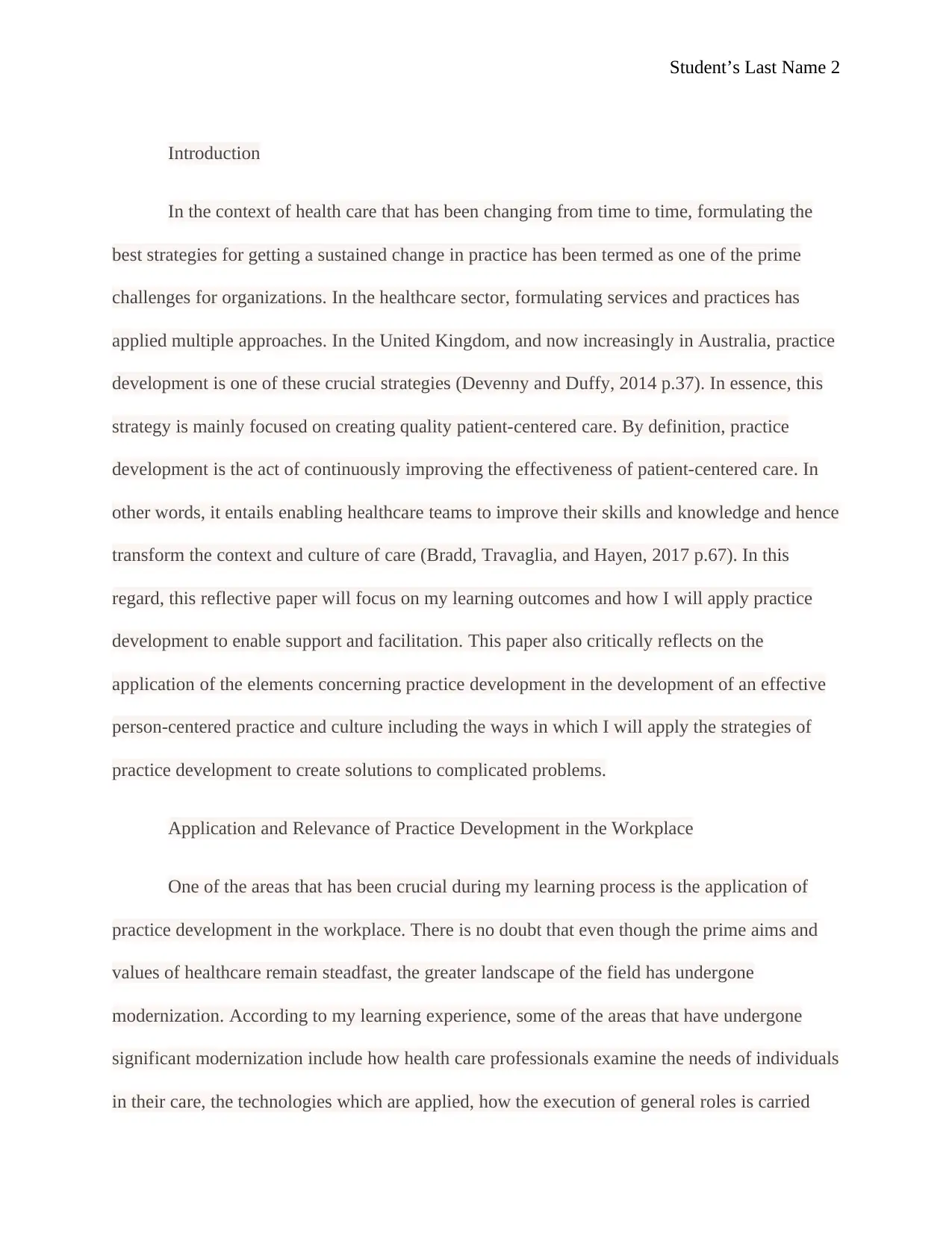
Student’s Last Name 2
Introduction
In the context of health care that has been changing from time to time, formulating the
best strategies for getting a sustained change in practice has been termed as one of the prime
challenges for organizations. In the healthcare sector, formulating services and practices has
applied multiple approaches. In the United Kingdom, and now increasingly in Australia, practice
development is one of these crucial strategies (Devenny and Duffy, 2014 p.37). In essence, this
strategy is mainly focused on creating quality patient-centered care. By definition, practice
development is the act of continuously improving the effectiveness of patient-centered care. In
other words, it entails enabling healthcare teams to improve their skills and knowledge and hence
transform the context and culture of care (Bradd, Travaglia, and Hayen, 2017 p.67). In this
regard, this reflective paper will focus on my learning outcomes and how I will apply practice
development to enable support and facilitation. This paper also critically reflects on the
application of the elements concerning practice development in the development of an effective
person-centered practice and culture including the ways in which I will apply the strategies of
practice development to create solutions to complicated problems.
Application and Relevance of Practice Development in the Workplace
One of the areas that has been crucial during my learning process is the application of
practice development in the workplace. There is no doubt that even though the prime aims and
values of healthcare remain steadfast, the greater landscape of the field has undergone
modernization. According to my learning experience, some of the areas that have undergone
significant modernization include how health care professionals examine the needs of individuals
in their care, the technologies which are applied, how the execution of general roles is carried
Introduction
In the context of health care that has been changing from time to time, formulating the
best strategies for getting a sustained change in practice has been termed as one of the prime
challenges for organizations. In the healthcare sector, formulating services and practices has
applied multiple approaches. In the United Kingdom, and now increasingly in Australia, practice
development is one of these crucial strategies (Devenny and Duffy, 2014 p.37). In essence, this
strategy is mainly focused on creating quality patient-centered care. By definition, practice
development is the act of continuously improving the effectiveness of patient-centered care. In
other words, it entails enabling healthcare teams to improve their skills and knowledge and hence
transform the context and culture of care (Bradd, Travaglia, and Hayen, 2017 p.67). In this
regard, this reflective paper will focus on my learning outcomes and how I will apply practice
development to enable support and facilitation. This paper also critically reflects on the
application of the elements concerning practice development in the development of an effective
person-centered practice and culture including the ways in which I will apply the strategies of
practice development to create solutions to complicated problems.
Application and Relevance of Practice Development in the Workplace
One of the areas that has been crucial during my learning process is the application of
practice development in the workplace. There is no doubt that even though the prime aims and
values of healthcare remain steadfast, the greater landscape of the field has undergone
modernization. According to my learning experience, some of the areas that have undergone
significant modernization include how health care professionals examine the needs of individuals
in their care, the technologies which are applied, how the execution of general roles is carried
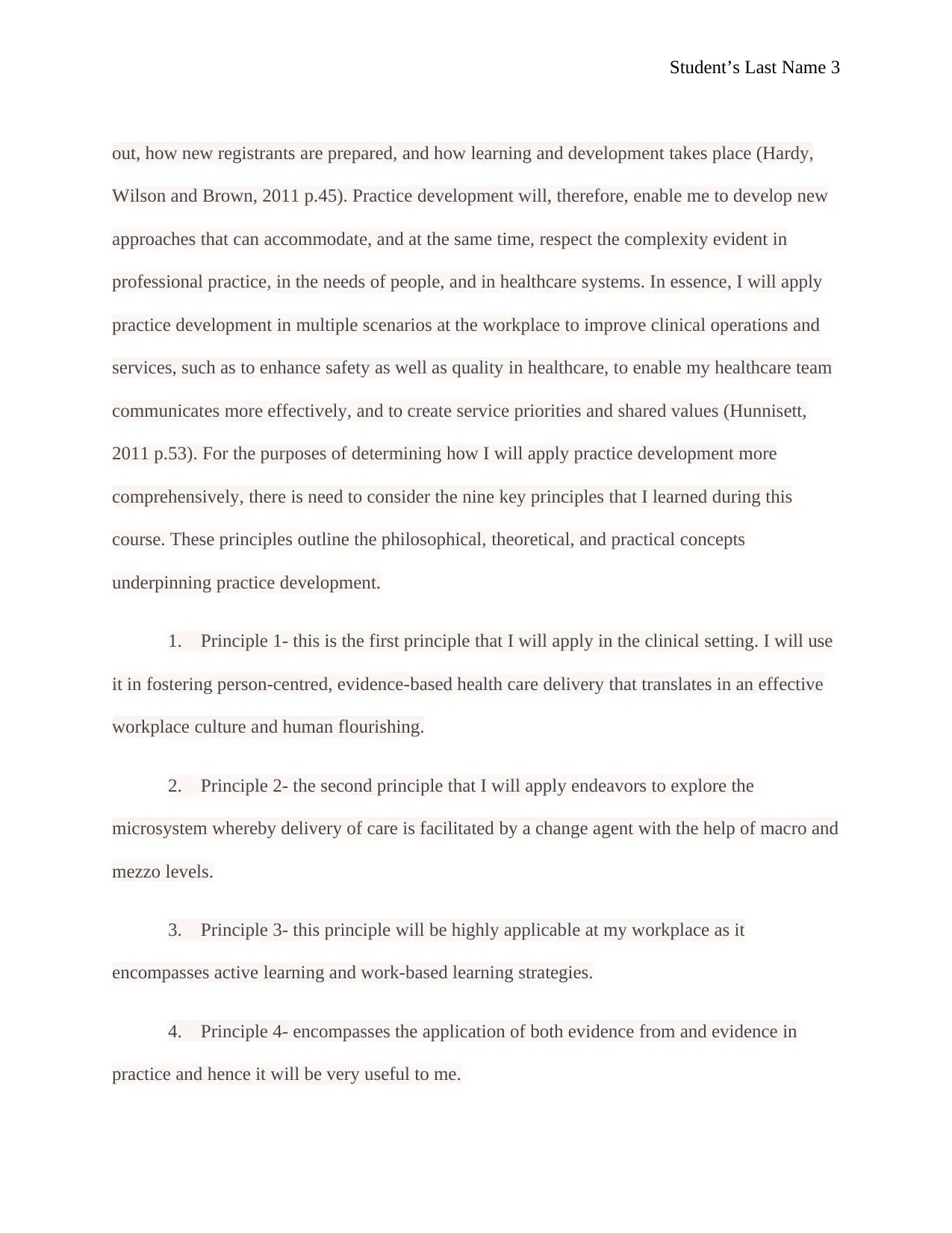
Student’s Last Name 3
out, how new registrants are prepared, and how learning and development takes place (Hardy,
Wilson and Brown, 2011 p.45). Practice development will, therefore, enable me to develop new
approaches that can accommodate, and at the same time, respect the complexity evident in
professional practice, in the needs of people, and in healthcare systems. In essence, I will apply
practice development in multiple scenarios at the workplace to improve clinical operations and
services, such as to enhance safety as well as quality in healthcare, to enable my healthcare team
communicates more effectively, and to create service priorities and shared values (Hunnisett,
2011 p.53). For the purposes of determining how I will apply practice development more
comprehensively, there is need to consider the nine key principles that I learned during this
course. These principles outline the philosophical, theoretical, and practical concepts
underpinning practice development.
1. Principle 1- this is the first principle that I will apply in the clinical setting. I will use
it in fostering person-centred, evidence-based health care delivery that translates in an effective
workplace culture and human flourishing.
2. Principle 2- the second principle that I will apply endeavors to explore the
microsystem whereby delivery of care is facilitated by a change agent with the help of macro and
mezzo levels.
3. Principle 3- this principle will be highly applicable at my workplace as it
encompasses active learning and work-based learning strategies.
4. Principle 4- encompasses the application of both evidence from and evidence in
practice and hence it will be very useful to me.
out, how new registrants are prepared, and how learning and development takes place (Hardy,
Wilson and Brown, 2011 p.45). Practice development will, therefore, enable me to develop new
approaches that can accommodate, and at the same time, respect the complexity evident in
professional practice, in the needs of people, and in healthcare systems. In essence, I will apply
practice development in multiple scenarios at the workplace to improve clinical operations and
services, such as to enhance safety as well as quality in healthcare, to enable my healthcare team
communicates more effectively, and to create service priorities and shared values (Hunnisett,
2011 p.53). For the purposes of determining how I will apply practice development more
comprehensively, there is need to consider the nine key principles that I learned during this
course. These principles outline the philosophical, theoretical, and practical concepts
underpinning practice development.
1. Principle 1- this is the first principle that I will apply in the clinical setting. I will use
it in fostering person-centred, evidence-based health care delivery that translates in an effective
workplace culture and human flourishing.
2. Principle 2- the second principle that I will apply endeavors to explore the
microsystem whereby delivery of care is facilitated by a change agent with the help of macro and
mezzo levels.
3. Principle 3- this principle will be highly applicable at my workplace as it
encompasses active learning and work-based learning strategies.
4. Principle 4- encompasses the application of both evidence from and evidence in
practice and hence it will be very useful to me.
⊘ This is a preview!⊘
Do you want full access?
Subscribe today to unlock all pages.

Trusted by 1+ million students worldwide
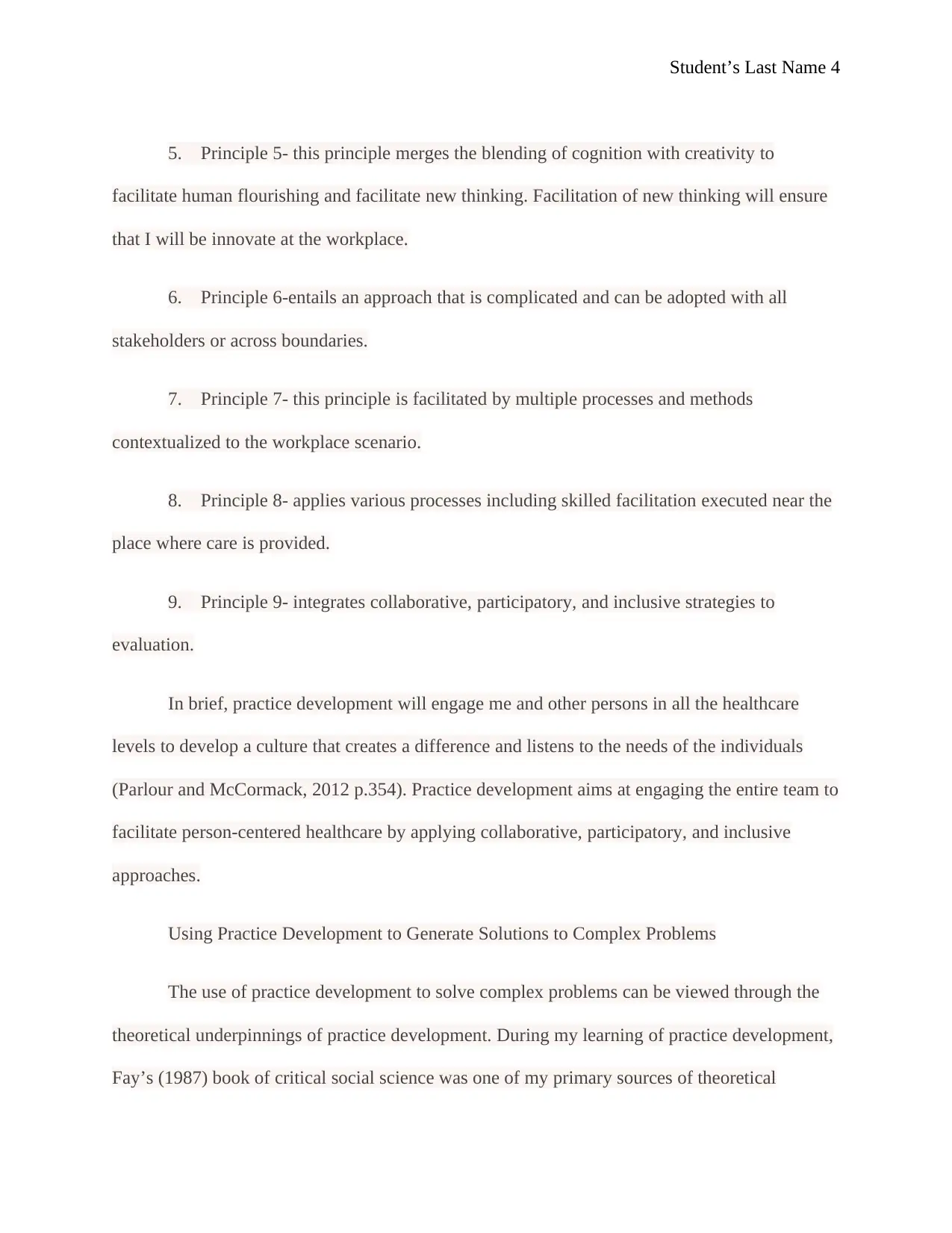
Student’s Last Name 4
5. Principle 5- this principle merges the blending of cognition with creativity to
facilitate human flourishing and facilitate new thinking. Facilitation of new thinking will ensure
that I will be innovate at the workplace.
6. Principle 6-entails an approach that is complicated and can be adopted with all
stakeholders or across boundaries.
7. Principle 7- this principle is facilitated by multiple processes and methods
contextualized to the workplace scenario.
8. Principle 8- applies various processes including skilled facilitation executed near the
place where care is provided.
9. Principle 9- integrates collaborative, participatory, and inclusive strategies to
evaluation.
In brief, practice development will engage me and other persons in all the healthcare
levels to develop a culture that creates a difference and listens to the needs of the individuals
(Parlour and McCormack, 2012 p.354). Practice development aims at engaging the entire team to
facilitate person-centered healthcare by applying collaborative, participatory, and inclusive
approaches.
Using Practice Development to Generate Solutions to Complex Problems
The use of practice development to solve complex problems can be viewed through the
theoretical underpinnings of practice development. During my learning of practice development,
Fay’s (1987) book of critical social science was one of my primary sources of theoretical
5. Principle 5- this principle merges the blending of cognition with creativity to
facilitate human flourishing and facilitate new thinking. Facilitation of new thinking will ensure
that I will be innovate at the workplace.
6. Principle 6-entails an approach that is complicated and can be adopted with all
stakeholders or across boundaries.
7. Principle 7- this principle is facilitated by multiple processes and methods
contextualized to the workplace scenario.
8. Principle 8- applies various processes including skilled facilitation executed near the
place where care is provided.
9. Principle 9- integrates collaborative, participatory, and inclusive strategies to
evaluation.
In brief, practice development will engage me and other persons in all the healthcare
levels to develop a culture that creates a difference and listens to the needs of the individuals
(Parlour and McCormack, 2012 p.354). Practice development aims at engaging the entire team to
facilitate person-centered healthcare by applying collaborative, participatory, and inclusive
approaches.
Using Practice Development to Generate Solutions to Complex Problems
The use of practice development to solve complex problems can be viewed through the
theoretical underpinnings of practice development. During my learning of practice development,
Fay’s (1987) book of critical social science was one of my primary sources of theoretical
Paraphrase This Document
Need a fresh take? Get an instant paraphrase of this document with our AI Paraphraser
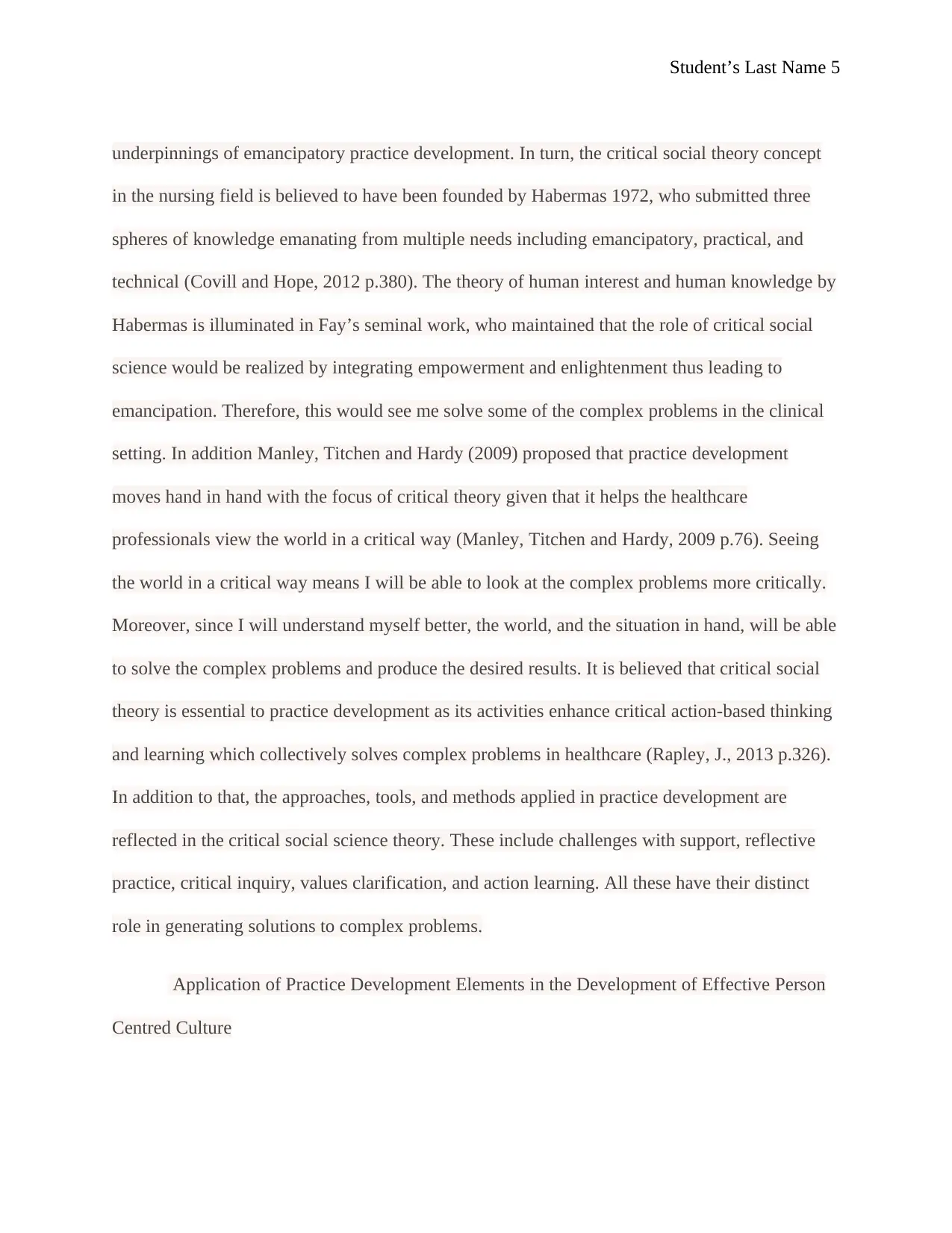
Student’s Last Name 5
underpinnings of emancipatory practice development. In turn, the critical social theory concept
in the nursing field is believed to have been founded by Habermas 1972, who submitted three
spheres of knowledge emanating from multiple needs including emancipatory, practical, and
technical (Covill and Hope, 2012 p.380). The theory of human interest and human knowledge by
Habermas is illuminated in Fay’s seminal work, who maintained that the role of critical social
science would be realized by integrating empowerment and enlightenment thus leading to
emancipation. Therefore, this would see me solve some of the complex problems in the clinical
setting. In addition Manley, Titchen and Hardy (2009) proposed that practice development
moves hand in hand with the focus of critical theory given that it helps the healthcare
professionals view the world in a critical way (Manley, Titchen and Hardy, 2009 p.76). Seeing
the world in a critical way means I will be able to look at the complex problems more critically.
Moreover, since I will understand myself better, the world, and the situation in hand, will be able
to solve the complex problems and produce the desired results. It is believed that critical social
theory is essential to practice development as its activities enhance critical action-based thinking
and learning which collectively solves complex problems in healthcare (Rapley, J., 2013 p.326).
In addition to that, the approaches, tools, and methods applied in practice development are
reflected in the critical social science theory. These include challenges with support, reflective
practice, critical inquiry, values clarification, and action learning. All these have their distinct
role in generating solutions to complex problems.
Application of Practice Development Elements in the Development of Effective Person
Centred Culture
underpinnings of emancipatory practice development. In turn, the critical social theory concept
in the nursing field is believed to have been founded by Habermas 1972, who submitted three
spheres of knowledge emanating from multiple needs including emancipatory, practical, and
technical (Covill and Hope, 2012 p.380). The theory of human interest and human knowledge by
Habermas is illuminated in Fay’s seminal work, who maintained that the role of critical social
science would be realized by integrating empowerment and enlightenment thus leading to
emancipation. Therefore, this would see me solve some of the complex problems in the clinical
setting. In addition Manley, Titchen and Hardy (2009) proposed that practice development
moves hand in hand with the focus of critical theory given that it helps the healthcare
professionals view the world in a critical way (Manley, Titchen and Hardy, 2009 p.76). Seeing
the world in a critical way means I will be able to look at the complex problems more critically.
Moreover, since I will understand myself better, the world, and the situation in hand, will be able
to solve the complex problems and produce the desired results. It is believed that critical social
theory is essential to practice development as its activities enhance critical action-based thinking
and learning which collectively solves complex problems in healthcare (Rapley, J., 2013 p.326).
In addition to that, the approaches, tools, and methods applied in practice development are
reflected in the critical social science theory. These include challenges with support, reflective
practice, critical inquiry, values clarification, and action learning. All these have their distinct
role in generating solutions to complex problems.
Application of Practice Development Elements in the Development of Effective Person
Centred Culture
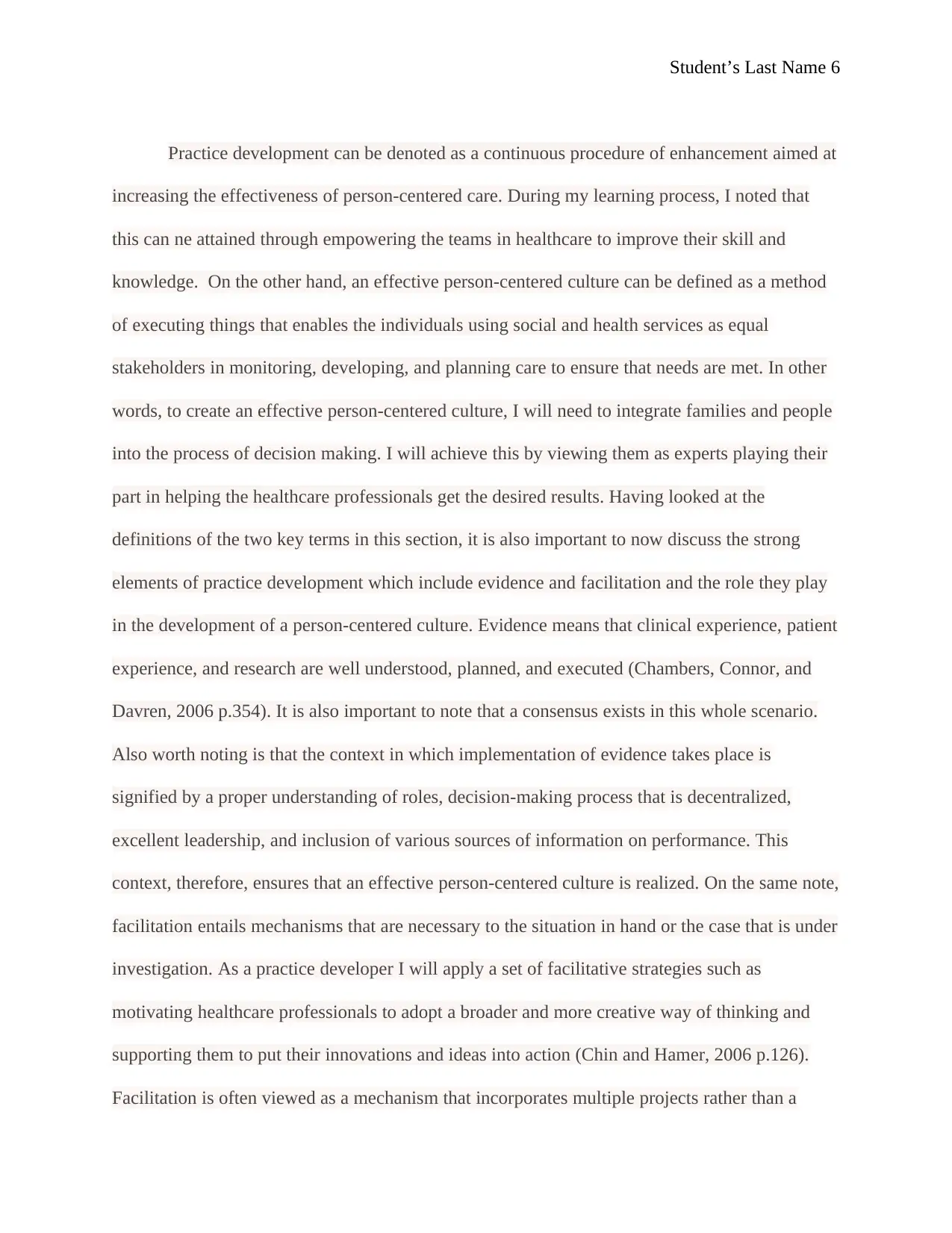
Student’s Last Name 6
Practice development can be denoted as a continuous procedure of enhancement aimed at
increasing the effectiveness of person-centered care. During my learning process, I noted that
this can ne attained through empowering the teams in healthcare to improve their skill and
knowledge. On the other hand, an effective person-centered culture can be defined as a method
of executing things that enables the individuals using social and health services as equal
stakeholders in monitoring, developing, and planning care to ensure that needs are met. In other
words, to create an effective person-centered culture, I will need to integrate families and people
into the process of decision making. I will achieve this by viewing them as experts playing their
part in helping the healthcare professionals get the desired results. Having looked at the
definitions of the two key terms in this section, it is also important to now discuss the strong
elements of practice development which include evidence and facilitation and the role they play
in the development of a person-centered culture. Evidence means that clinical experience, patient
experience, and research are well understood, planned, and executed (Chambers, Connor, and
Davren, 2006 p.354). It is also important to note that a consensus exists in this whole scenario.
Also worth noting is that the context in which implementation of evidence takes place is
signified by a proper understanding of roles, decision-making process that is decentralized,
excellent leadership, and inclusion of various sources of information on performance. This
context, therefore, ensures that an effective person-centered culture is realized. On the same note,
facilitation entails mechanisms that are necessary to the situation in hand or the case that is under
investigation. As a practice developer I will apply a set of facilitative strategies such as
motivating healthcare professionals to adopt a broader and more creative way of thinking and
supporting them to put their innovations and ideas into action (Chin and Hamer, 2006 p.126).
Facilitation is often viewed as a mechanism that incorporates multiple projects rather than a
Practice development can be denoted as a continuous procedure of enhancement aimed at
increasing the effectiveness of person-centered care. During my learning process, I noted that
this can ne attained through empowering the teams in healthcare to improve their skill and
knowledge. On the other hand, an effective person-centered culture can be defined as a method
of executing things that enables the individuals using social and health services as equal
stakeholders in monitoring, developing, and planning care to ensure that needs are met. In other
words, to create an effective person-centered culture, I will need to integrate families and people
into the process of decision making. I will achieve this by viewing them as experts playing their
part in helping the healthcare professionals get the desired results. Having looked at the
definitions of the two key terms in this section, it is also important to now discuss the strong
elements of practice development which include evidence and facilitation and the role they play
in the development of a person-centered culture. Evidence means that clinical experience, patient
experience, and research are well understood, planned, and executed (Chambers, Connor, and
Davren, 2006 p.354). It is also important to note that a consensus exists in this whole scenario.
Also worth noting is that the context in which implementation of evidence takes place is
signified by a proper understanding of roles, decision-making process that is decentralized,
excellent leadership, and inclusion of various sources of information on performance. This
context, therefore, ensures that an effective person-centered culture is realized. On the same note,
facilitation entails mechanisms that are necessary to the situation in hand or the case that is under
investigation. As a practice developer I will apply a set of facilitative strategies such as
motivating healthcare professionals to adopt a broader and more creative way of thinking and
supporting them to put their innovations and ideas into action (Chin and Hamer, 2006 p.126).
Facilitation is often viewed as a mechanism that incorporates multiple projects rather than a
⊘ This is a preview!⊘
Do you want full access?
Subscribe today to unlock all pages.

Trusted by 1+ million students worldwide
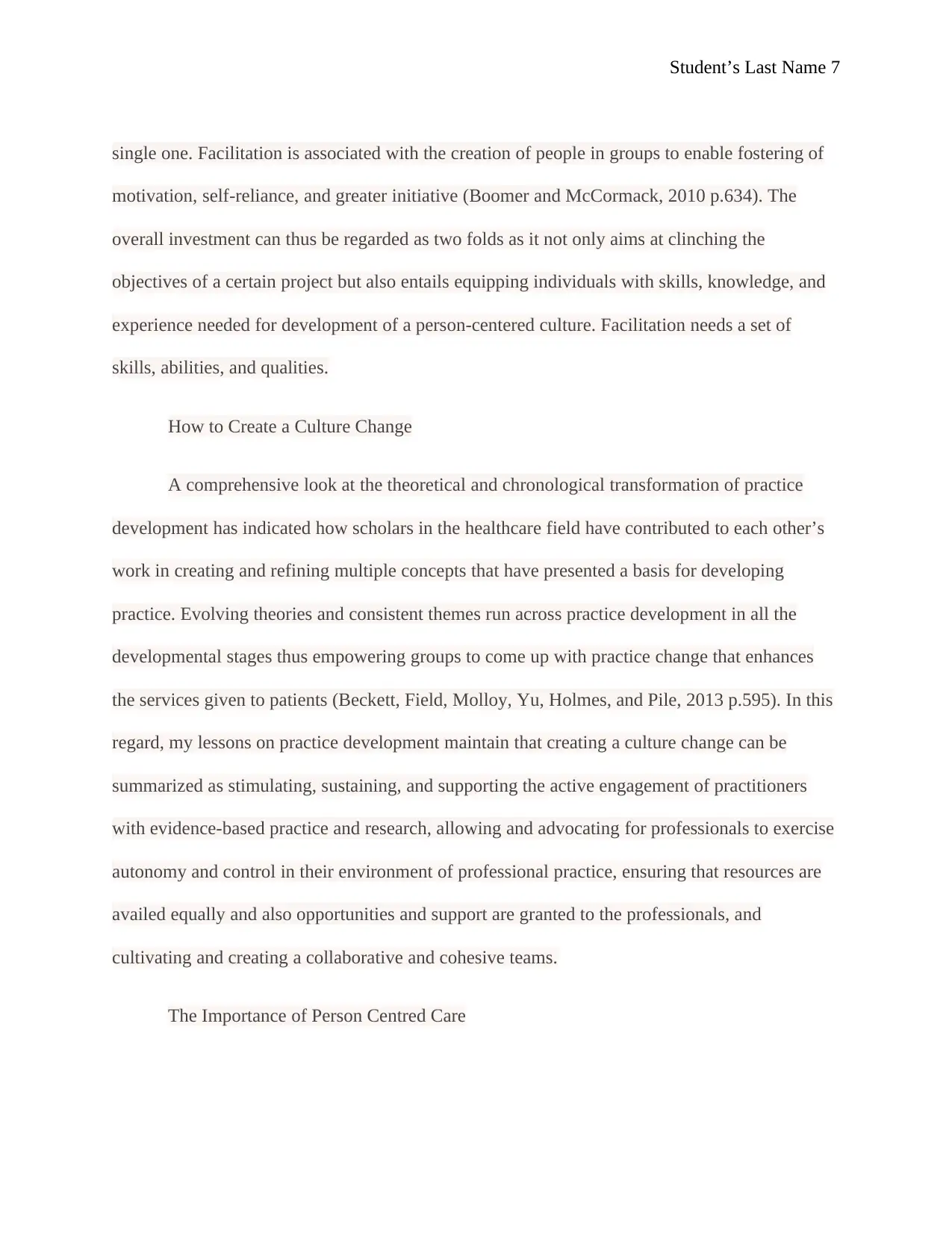
Student’s Last Name 7
single one. Facilitation is associated with the creation of people in groups to enable fostering of
motivation, self-reliance, and greater initiative (Boomer and McCormack, 2010 p.634). The
overall investment can thus be regarded as two folds as it not only aims at clinching the
objectives of a certain project but also entails equipping individuals with skills, knowledge, and
experience needed for development of a person-centered culture. Facilitation needs a set of
skills, abilities, and qualities.
How to Create a Culture Change
A comprehensive look at the theoretical and chronological transformation of practice
development has indicated how scholars in the healthcare field have contributed to each other’s
work in creating and refining multiple concepts that have presented a basis for developing
practice. Evolving theories and consistent themes run across practice development in all the
developmental stages thus empowering groups to come up with practice change that enhances
the services given to patients (Beckett, Field, Molloy, Yu, Holmes, and Pile, 2013 p.595). In this
regard, my lessons on practice development maintain that creating a culture change can be
summarized as stimulating, sustaining, and supporting the active engagement of practitioners
with evidence-based practice and research, allowing and advocating for professionals to exercise
autonomy and control in their environment of professional practice, ensuring that resources are
availed equally and also opportunities and support are granted to the professionals, and
cultivating and creating a collaborative and cohesive teams.
The Importance of Person Centred Care
single one. Facilitation is associated with the creation of people in groups to enable fostering of
motivation, self-reliance, and greater initiative (Boomer and McCormack, 2010 p.634). The
overall investment can thus be regarded as two folds as it not only aims at clinching the
objectives of a certain project but also entails equipping individuals with skills, knowledge, and
experience needed for development of a person-centered culture. Facilitation needs a set of
skills, abilities, and qualities.
How to Create a Culture Change
A comprehensive look at the theoretical and chronological transformation of practice
development has indicated how scholars in the healthcare field have contributed to each other’s
work in creating and refining multiple concepts that have presented a basis for developing
practice. Evolving theories and consistent themes run across practice development in all the
developmental stages thus empowering groups to come up with practice change that enhances
the services given to patients (Beckett, Field, Molloy, Yu, Holmes, and Pile, 2013 p.595). In this
regard, my lessons on practice development maintain that creating a culture change can be
summarized as stimulating, sustaining, and supporting the active engagement of practitioners
with evidence-based practice and research, allowing and advocating for professionals to exercise
autonomy and control in their environment of professional practice, ensuring that resources are
availed equally and also opportunities and support are granted to the professionals, and
cultivating and creating a collaborative and cohesive teams.
The Importance of Person Centred Care
Paraphrase This Document
Need a fresh take? Get an instant paraphrase of this document with our AI Paraphraser
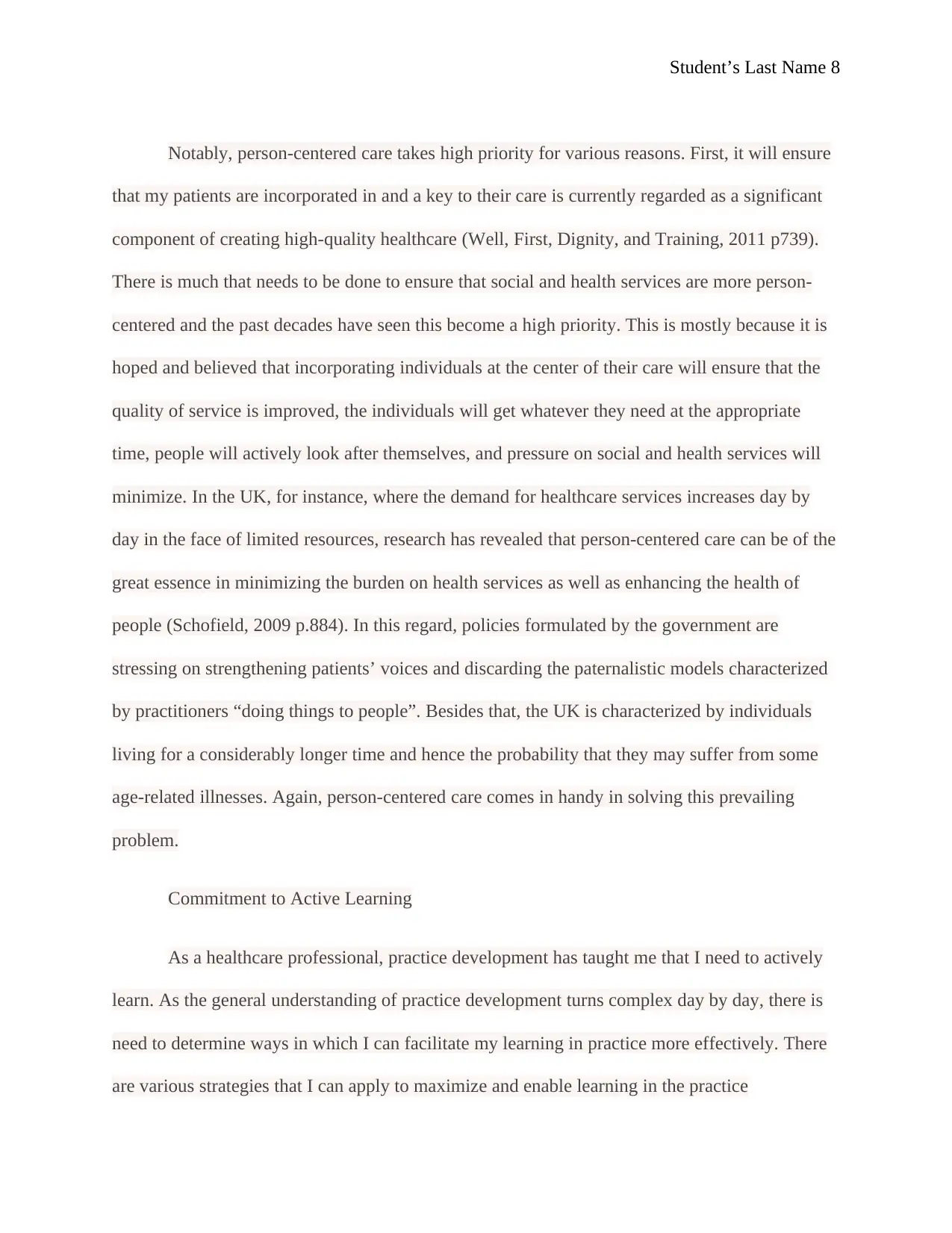
Student’s Last Name 8
Notably, person-centered care takes high priority for various reasons. First, it will ensure
that my patients are incorporated in and a key to their care is currently regarded as a significant
component of creating high-quality healthcare (Well, First, Dignity, and Training, 2011 p739).
There is much that needs to be done to ensure that social and health services are more person-
centered and the past decades have seen this become a high priority. This is mostly because it is
hoped and believed that incorporating individuals at the center of their care will ensure that the
quality of service is improved, the individuals will get whatever they need at the appropriate
time, people will actively look after themselves, and pressure on social and health services will
minimize. In the UK, for instance, where the demand for healthcare services increases day by
day in the face of limited resources, research has revealed that person-centered care can be of the
great essence in minimizing the burden on health services as well as enhancing the health of
people (Schofield, 2009 p.884). In this regard, policies formulated by the government are
stressing on strengthening patients’ voices and discarding the paternalistic models characterized
by practitioners “doing things to people”. Besides that, the UK is characterized by individuals
living for a considerably longer time and hence the probability that they may suffer from some
age-related illnesses. Again, person-centered care comes in handy in solving this prevailing
problem.
Commitment to Active Learning
As a healthcare professional, practice development has taught me that I need to actively
learn. As the general understanding of practice development turns complex day by day, there is
need to determine ways in which I can facilitate my learning in practice more effectively. There
are various strategies that I can apply to maximize and enable learning in the practice
Notably, person-centered care takes high priority for various reasons. First, it will ensure
that my patients are incorporated in and a key to their care is currently regarded as a significant
component of creating high-quality healthcare (Well, First, Dignity, and Training, 2011 p739).
There is much that needs to be done to ensure that social and health services are more person-
centered and the past decades have seen this become a high priority. This is mostly because it is
hoped and believed that incorporating individuals at the center of their care will ensure that the
quality of service is improved, the individuals will get whatever they need at the appropriate
time, people will actively look after themselves, and pressure on social and health services will
minimize. In the UK, for instance, where the demand for healthcare services increases day by
day in the face of limited resources, research has revealed that person-centered care can be of the
great essence in minimizing the burden on health services as well as enhancing the health of
people (Schofield, 2009 p.884). In this regard, policies formulated by the government are
stressing on strengthening patients’ voices and discarding the paternalistic models characterized
by practitioners “doing things to people”. Besides that, the UK is characterized by individuals
living for a considerably longer time and hence the probability that they may suffer from some
age-related illnesses. Again, person-centered care comes in handy in solving this prevailing
problem.
Commitment to Active Learning
As a healthcare professional, practice development has taught me that I need to actively
learn. As the general understanding of practice development turns complex day by day, there is
need to determine ways in which I can facilitate my learning in practice more effectively. There
are various strategies that I can apply to maximize and enable learning in the practice
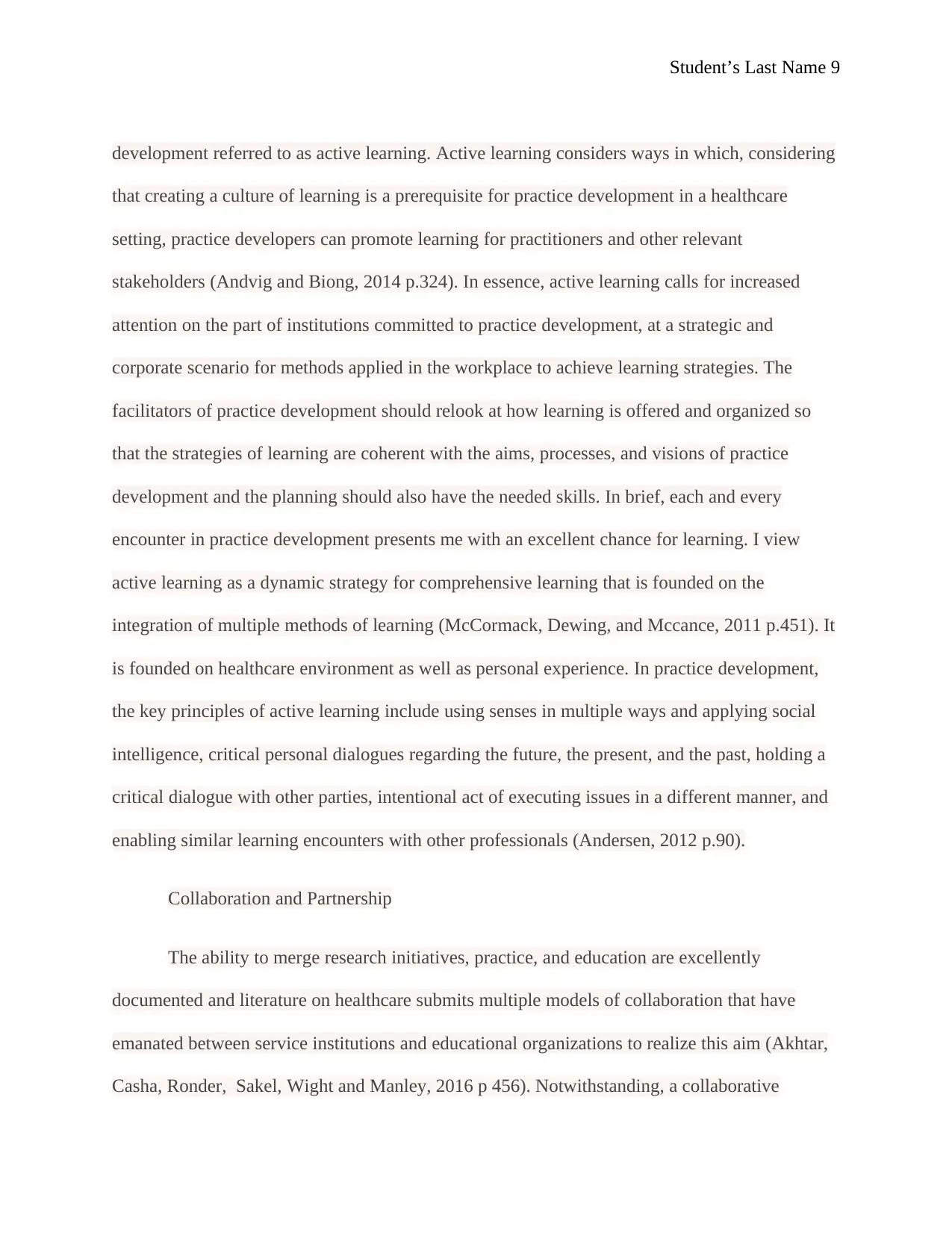
Student’s Last Name 9
development referred to as active learning. Active learning considers ways in which, considering
that creating a culture of learning is a prerequisite for practice development in a healthcare
setting, practice developers can promote learning for practitioners and other relevant
stakeholders (Andvig and Biong, 2014 p.324). In essence, active learning calls for increased
attention on the part of institutions committed to practice development, at a strategic and
corporate scenario for methods applied in the workplace to achieve learning strategies. The
facilitators of practice development should relook at how learning is offered and organized so
that the strategies of learning are coherent with the aims, processes, and visions of practice
development and the planning should also have the needed skills. In brief, each and every
encounter in practice development presents me with an excellent chance for learning. I view
active learning as a dynamic strategy for comprehensive learning that is founded on the
integration of multiple methods of learning (McCormack, Dewing, and Mccance, 2011 p.451). It
is founded on healthcare environment as well as personal experience. In practice development,
the key principles of active learning include using senses in multiple ways and applying social
intelligence, critical personal dialogues regarding the future, the present, and the past, holding a
critical dialogue with other parties, intentional act of executing issues in a different manner, and
enabling similar learning encounters with other professionals (Andersen, 2012 p.90).
Collaboration and Partnership
The ability to merge research initiatives, practice, and education are excellently
documented and literature on healthcare submits multiple models of collaboration that have
emanated between service institutions and educational organizations to realize this aim (Akhtar,
Casha, Ronder, Sakel, Wight and Manley, 2016 p 456). Notwithstanding, a collaborative
development referred to as active learning. Active learning considers ways in which, considering
that creating a culture of learning is a prerequisite for practice development in a healthcare
setting, practice developers can promote learning for practitioners and other relevant
stakeholders (Andvig and Biong, 2014 p.324). In essence, active learning calls for increased
attention on the part of institutions committed to practice development, at a strategic and
corporate scenario for methods applied in the workplace to achieve learning strategies. The
facilitators of practice development should relook at how learning is offered and organized so
that the strategies of learning are coherent with the aims, processes, and visions of practice
development and the planning should also have the needed skills. In brief, each and every
encounter in practice development presents me with an excellent chance for learning. I view
active learning as a dynamic strategy for comprehensive learning that is founded on the
integration of multiple methods of learning (McCormack, Dewing, and Mccance, 2011 p.451). It
is founded on healthcare environment as well as personal experience. In practice development,
the key principles of active learning include using senses in multiple ways and applying social
intelligence, critical personal dialogues regarding the future, the present, and the past, holding a
critical dialogue with other parties, intentional act of executing issues in a different manner, and
enabling similar learning encounters with other professionals (Andersen, 2012 p.90).
Collaboration and Partnership
The ability to merge research initiatives, practice, and education are excellently
documented and literature on healthcare submits multiple models of collaboration that have
emanated between service institutions and educational organizations to realize this aim (Akhtar,
Casha, Ronder, Sakel, Wight and Manley, 2016 p 456). Notwithstanding, a collaborative
⊘ This is a preview!⊘
Do you want full access?
Subscribe today to unlock all pages.

Trusted by 1+ million students worldwide
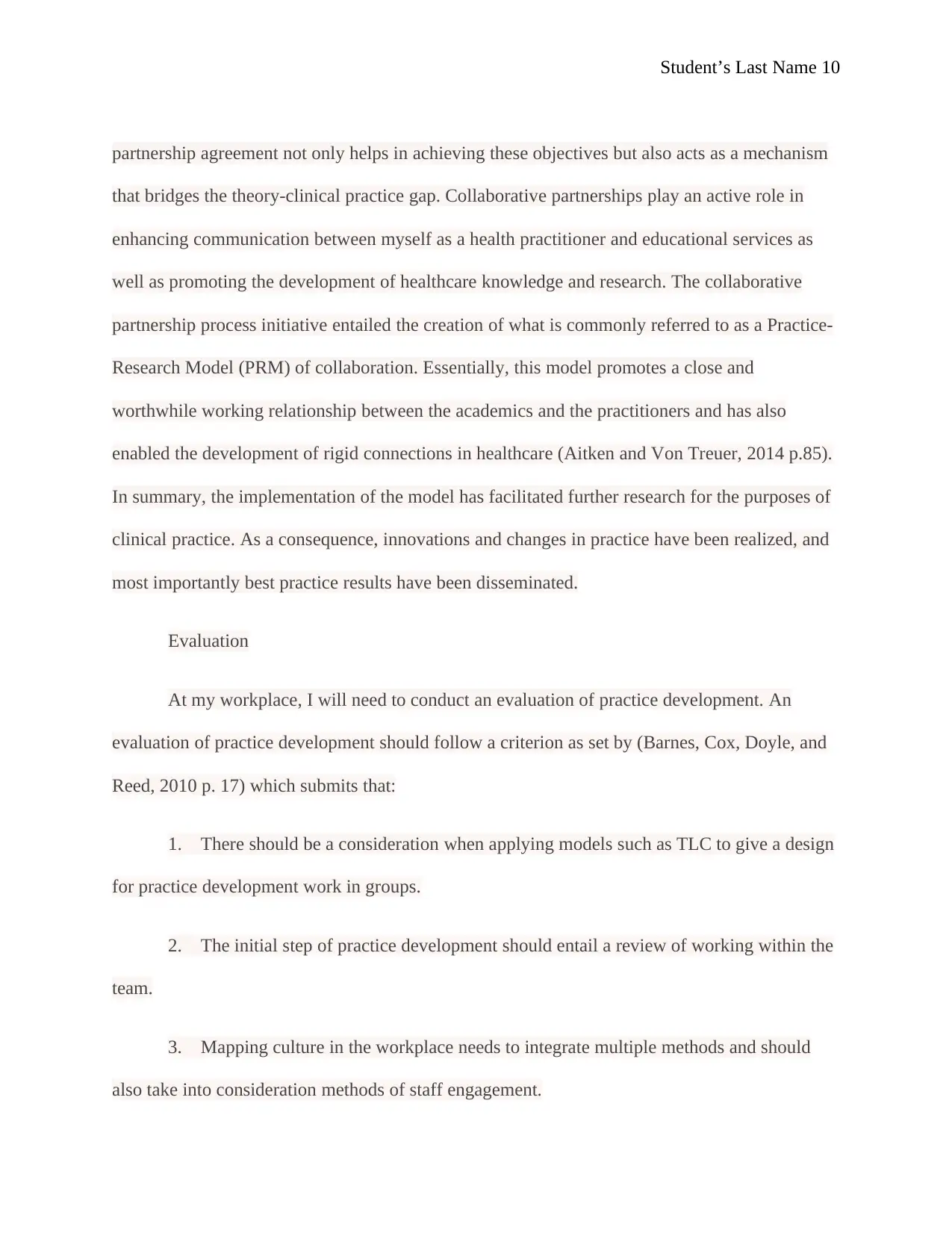
Student’s Last Name 10
partnership agreement not only helps in achieving these objectives but also acts as a mechanism
that bridges the theory-clinical practice gap. Collaborative partnerships play an active role in
enhancing communication between myself as a health practitioner and educational services as
well as promoting the development of healthcare knowledge and research. The collaborative
partnership process initiative entailed the creation of what is commonly referred to as a Practice-
Research Model (PRM) of collaboration. Essentially, this model promotes a close and
worthwhile working relationship between the academics and the practitioners and has also
enabled the development of rigid connections in healthcare (Aitken and Von Treuer, 2014 p.85).
In summary, the implementation of the model has facilitated further research for the purposes of
clinical practice. As a consequence, innovations and changes in practice have been realized, and
most importantly best practice results have been disseminated.
Evaluation
At my workplace, I will need to conduct an evaluation of practice development. An
evaluation of practice development should follow a criterion as set by (Barnes, Cox, Doyle, and
Reed, 2010 p. 17) which submits that:
1. There should be a consideration when applying models such as TLC to give a design
for practice development work in groups.
2. The initial step of practice development should entail a review of working within the
team.
3. Mapping culture in the workplace needs to integrate multiple methods and should
also take into consideration methods of staff engagement.
partnership agreement not only helps in achieving these objectives but also acts as a mechanism
that bridges the theory-clinical practice gap. Collaborative partnerships play an active role in
enhancing communication between myself as a health practitioner and educational services as
well as promoting the development of healthcare knowledge and research. The collaborative
partnership process initiative entailed the creation of what is commonly referred to as a Practice-
Research Model (PRM) of collaboration. Essentially, this model promotes a close and
worthwhile working relationship between the academics and the practitioners and has also
enabled the development of rigid connections in healthcare (Aitken and Von Treuer, 2014 p.85).
In summary, the implementation of the model has facilitated further research for the purposes of
clinical practice. As a consequence, innovations and changes in practice have been realized, and
most importantly best practice results have been disseminated.
Evaluation
At my workplace, I will need to conduct an evaluation of practice development. An
evaluation of practice development should follow a criterion as set by (Barnes, Cox, Doyle, and
Reed, 2010 p. 17) which submits that:
1. There should be a consideration when applying models such as TLC to give a design
for practice development work in groups.
2. The initial step of practice development should entail a review of working within the
team.
3. Mapping culture in the workplace needs to integrate multiple methods and should
also take into consideration methods of staff engagement.
Paraphrase This Document
Need a fresh take? Get an instant paraphrase of this document with our AI Paraphraser
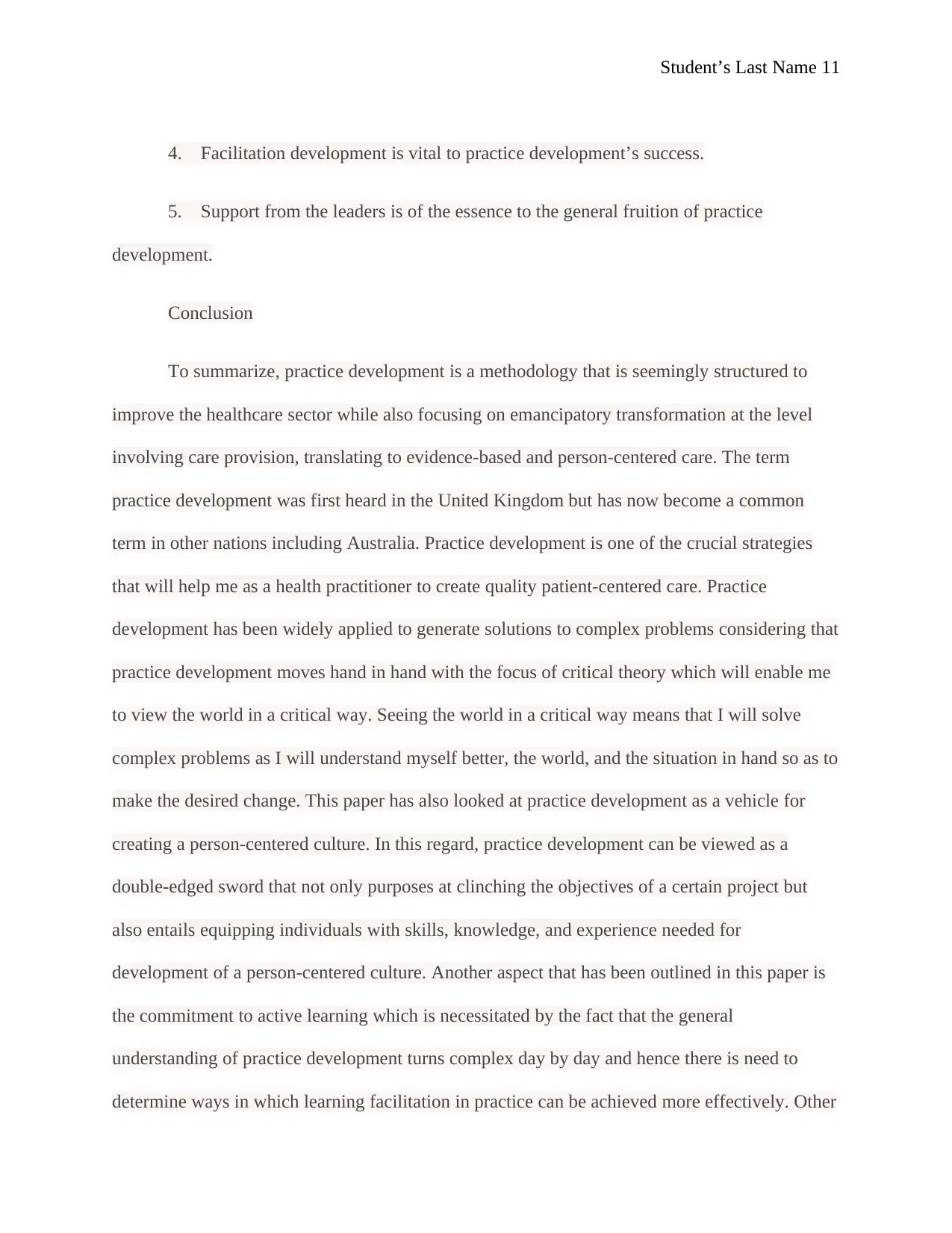
Student’s Last Name 11
4. Facilitation development is vital to practice development’s success.
5. Support from the leaders is of the essence to the general fruition of practice
development.
Conclusion
To summarize, practice development is a methodology that is seemingly structured to
improve the healthcare sector while also focusing on emancipatory transformation at the level
involving care provision, translating to evidence-based and person-centered care. The term
practice development was first heard in the United Kingdom but has now become a common
term in other nations including Australia. Practice development is one of the crucial strategies
that will help me as a health practitioner to create quality patient-centered care. Practice
development has been widely applied to generate solutions to complex problems considering that
practice development moves hand in hand with the focus of critical theory which will enable me
to view the world in a critical way. Seeing the world in a critical way means that I will solve
complex problems as I will understand myself better, the world, and the situation in hand so as to
make the desired change. This paper has also looked at practice development as a vehicle for
creating a person-centered culture. In this regard, practice development can be viewed as a
double-edged sword that not only purposes at clinching the objectives of a certain project but
also entails equipping individuals with skills, knowledge, and experience needed for
development of a person-centered culture. Another aspect that has been outlined in this paper is
the commitment to active learning which is necessitated by the fact that the general
understanding of practice development turns complex day by day and hence there is need to
determine ways in which learning facilitation in practice can be achieved more effectively. Other
4. Facilitation development is vital to practice development’s success.
5. Support from the leaders is of the essence to the general fruition of practice
development.
Conclusion
To summarize, practice development is a methodology that is seemingly structured to
improve the healthcare sector while also focusing on emancipatory transformation at the level
involving care provision, translating to evidence-based and person-centered care. The term
practice development was first heard in the United Kingdom but has now become a common
term in other nations including Australia. Practice development is one of the crucial strategies
that will help me as a health practitioner to create quality patient-centered care. Practice
development has been widely applied to generate solutions to complex problems considering that
practice development moves hand in hand with the focus of critical theory which will enable me
to view the world in a critical way. Seeing the world in a critical way means that I will solve
complex problems as I will understand myself better, the world, and the situation in hand so as to
make the desired change. This paper has also looked at practice development as a vehicle for
creating a person-centered culture. In this regard, practice development can be viewed as a
double-edged sword that not only purposes at clinching the objectives of a certain project but
also entails equipping individuals with skills, knowledge, and experience needed for
development of a person-centered culture. Another aspect that has been outlined in this paper is
the commitment to active learning which is necessitated by the fact that the general
understanding of practice development turns complex day by day and hence there is need to
determine ways in which learning facilitation in practice can be achieved more effectively. Other

Student’s Last Name 12
significant areas that have been discussed include partnership and collaboration, how to create a
culture change, and the importance of person-centered care.
significant areas that have been discussed include partnership and collaboration, how to create a
culture change, and the importance of person-centered care.
⊘ This is a preview!⊘
Do you want full access?
Subscribe today to unlock all pages.

Trusted by 1+ million students worldwide
1 out of 14
Related Documents
Your All-in-One AI-Powered Toolkit for Academic Success.
+13062052269
info@desklib.com
Available 24*7 on WhatsApp / Email
![[object Object]](/_next/static/media/star-bottom.7253800d.svg)
Unlock your academic potential
Copyright © 2020–2025 A2Z Services. All Rights Reserved. Developed and managed by ZUCOL.





